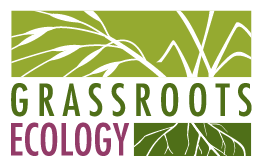Reflections of a New Mom on Earth Day
By Talia Kirschner, Grants and Development Manager
I remember a sky that turned purple at night instead of black; leaf shadows dappling the concrete from street trees as I walked to school in the morning alongside lanes bustling with cars. Growing up in the city, nature was all around me—and yet it was obscured. It was nothing short of an imaginative act to envision the soil beneath the pavement I walked each day, water beneath the soil.
It wasn’t until early adulthood that I began to seek out pristine wild space where I could feel connected to the earth in a less abstract way. I explored California’s deserts, redwoods, and High Sierra. I marveled at wildflowers and mushrooms and learned about native plants and their uses. And I dedicated my career to supporting environmental nonprofits that help youth connect to nature.
Over a year ago now, I had my first child. Her story begins differently. We are lucky to live in a place where open space is within easy reach. We walked together often throughout her first year of life, my daughter nestled up close to me in the carrier. The more I walked, the more she slept--and so our hiking became ritual.
Now she can walk the trails on her own two feet. I watch her build confidence navigating not only the smooth floors and sidewalks of the urban environment, but also the uneven slopes of grass, gravel, and earth. She waddles forward on bowed legs, falls, inspects the dirt on her hands. Keeps going.
As an infant, she would often look skyward, captivated by the shadow play of the tree canopy. A toddler now, her gaze hovers earthward, catching what I sometimes fail to see. Walking along a field one morning, she lets out an exclamation of delight upon sighting a Great Blue Heron stalking its prey, so still it had almost seemed inanimate. How sweet to witness her astonishment at this strange and beautiful creature! Bird, I say to her. Heron. I name the plants we pass as well: Ceanothus, buttercup, buckeye, fiddleneck. She looks back at me thoughtfully, utters: Bah.
Indoors, she leafs through board books filled with prototypes of the world around us: sun, tree, flower, cloud, bug. How long, I wonder, until she connects these cartoony images to the more nuanced world we experience outside?
Her favorite books are filled with pictures of animals and picturesque scenes of forests, rolling hills, coral reefs teeming with colorful sea creatures. Sadly, many of these species may no longer exist by the time she is grown, habitats whittled down to fragments of what they once were. I think about having to explain to her the meaning of extinction. Death of a species.
With all this in mind, it feels wrong in some way to show her their pictures, teach her their names. Because between these books and our frequent walks through idyllic open spaces, I’m creating an expectation of a world bursting with diverse life and beauty—a harmonious world in which humans revere the earth and the many living things that inhabit it. Where we make space for each other, understanding that the whole is greater than the sum of its parts.
But unfortunately, that vision is not reality. While important vestiges of the earth’s abundance persevere in the places people have had the foresight and determination to preserve and restore, the larger global trend being borne out today is the disintegration of biodiversity at the hands of human impetuosity.
I think about this stuff often, not just on Earth Day. Don’t we all, especially now? With a climate change denier in the White House and an Environmental Protection Agency that is itself endangered, it’s hard to keep a positive outlook on the future. And yet there is this wonderful little person I brought into the world, who will be occupying this space a lot longer than I will. I must keep hope so I can teach hope.
And so I continue to bring her outside, to teach her the words, to build her sense of connection to the earth around her—knowing that all the joy and wisdom this will bring her will be muddled with sorrow for what’s been lost. But she must understand what is at stake, so that she can fight for it. And she must understand that the battle isn’t only for the trees and the oceans, the rhinos and the gorillas—but for herself, for her friends, family, and fellow world citizens. If something is worth fighting for, this is it. This is, literally, everything.
Happy Earth Day, little one. Put up your dukes.




